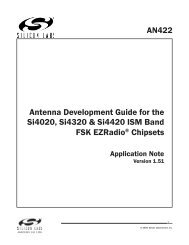C8051F326/7 - Silicon Labs
C8051F326/7 - Silicon Labs
C8051F326/7 - Silicon Labs
Create successful ePaper yourself
Turn your PDF publications into a flip-book with our unique Google optimized e-Paper software.
8. Flash Memory<br />
<strong>C8051F326</strong>/7<br />
On-chip, re-programmable Flash memory is included for program code and non-volatile data storage. The<br />
Flash memory can be programmed in-system, a single byte at a time, through the C2 interface or by software<br />
using the MOVX instruction. Once cleared to logic 0, a Flash bit must be erased to set it back to logic<br />
1. Flash bytes would typically be erased (set to 0xFF) before being reprogrammed. The write and erase<br />
operations are automatically timed by hardware for proper execution; data polling to determine the end of<br />
the write/erase operation is not required. Code execution is stalled during a Flash write/erase operation.<br />
Refer to Table 8.1 for complete Flash memory electrical characteristics.<br />
8.1. Programming The Flash Memory<br />
The simplest means of programming the Flash memory is through the C2 interface using programming<br />
tools provided by <strong>Silicon</strong> Laboratories or a third party vendor. This is the only means for programming a<br />
non-initialized device. For details on the C2 commands to program Flash memory, see Section “15. C2<br />
Interface” on page 135.<br />
To ensure the integrity of Flash contents, it is strongly recommended that the on-chip VDD Monitor<br />
be enabled in any system that includes code that writes and/or erases Flash memory from software.<br />
8.1.1. Flash Lock and Key Functions<br />
Flash writes and erases by user software are protected with a lock and key function. The Flash Lock and<br />
Key Register (FLKEY) must be written with the correct key codes, in sequence, before Flash operations<br />
may be performed. The key codes are: 0xA5, 0xF1. The timing does not matter, but the codes must be<br />
written in order. If the key codes are written out of order, or the wrong codes are written, Flash writes and<br />
erases will be disabled until the next system reset. Flash writes and erases will also be disabled if a Flash<br />
write or erase is attempted before the key codes have been written properly. The Flash lock resets after<br />
each write or erase; the key codes must be written again before a following Flash operation can be performed.<br />
The FLKEY register is detailed in Figure 8.2.<br />
8.1.2. Flash Erase Procedure<br />
The Flash memory can be programmed by software using the MOVX write instruction with the address and<br />
data byte to be programmed provided as normal operands. Before writing to Flash memory using MOVX,<br />
Flash write operations must be enabled by: (1) Writing the Flash key codes in sequence to the Flash Lock<br />
register (FLKEY); and (2) Setting the PSWE Program Store Write Enable bit (PSCTL.0) to logic 1 (this<br />
directs the MOVX writes to target Flash memory). The PSWE bit remains set until cleared by software.<br />
A write to Flash memory can clear bits to logic 0 but cannot set them; only an erase operation can set bits<br />
to logic 1 in Flash. A byte location to be programmed must be erased before a new value is written.<br />
The Flash memory is organized in 512-byte pages. The erase operation applies to an entire page (setting<br />
all bytes in the page to 0xFF). To erase an entire 512-byte page, perform the following steps:<br />
Step 1. Disable interrupts (recommended).<br />
Step 2. Write the first key code to FLKEY: 0xA5.<br />
Step 3. Write the second key code to FLKEY: 0xF1.<br />
Step 4. Set the PSEE bit (register PSCTL).<br />
Step 5. Set the PSWE bit (register PSCTL).<br />
Step 6. Using the MOVX instruction, write a data byte to any location within the 512-byte page to<br />
be erased.<br />
Step 7. Clear the PSWE bit (register PSCTL).<br />
Step 8. Clear the PSEE bit (register PSCTI).<br />
Rev. 1.1 63


